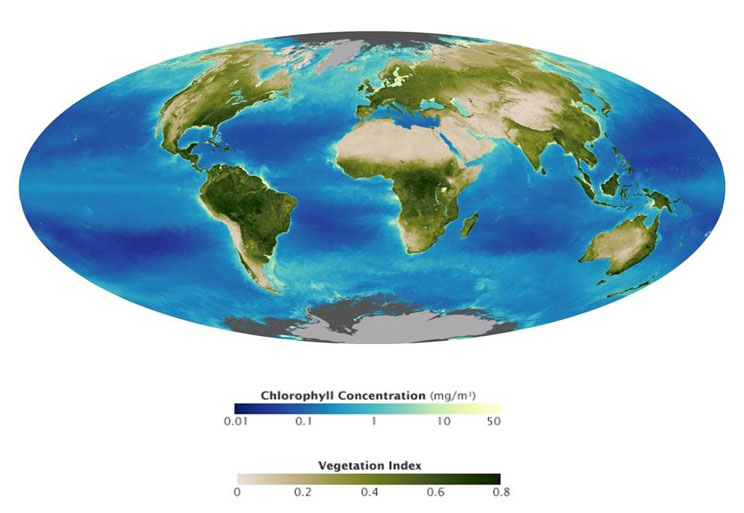What Is The Main Energy Source For Most Plants And Animals?
Carbon acts as an energy currency in ecosystems because light is converted to organic carbon compounds (sugars, fats, proteins), and organic carbon compounds are then converted to chemical free energy. Hence, the full amount of organic textile that is produced by plants is directly related to the amount of light energy that is absorbed. This is primary production, a term that refers to the growth of plants or change in their full biomass. It is referred to as 'primary' production because it is biomass that is produced straight from COii, whereas secondary product is produced from already existing organic textile. Primary production is expressed in terms of carbon fixed per unit fourth dimension and per unit infinite, and represents a central property of an ecosystem, which is the rate of energy generated over time.

Figure 1: NASA satellite image of the global biosphere in 2008
Light-green shading on land shows the normalized difference vegetation alphabetize (NDVI), which is strongly correlated with establish master production. Blue shading in the oceans depicts surface chlorophyll concentrations; chlorophyll concentrations are directly related to the affluence of microscopic marine plants, or phytoplankton, and can exist used to quantify marine primary production. (Courtesy of NASA Earth Observatory)
As one might imagine, measuring all plant growth in a forest or all phytoplankton growth in a sea is extremely challenging. Nevertheless, because this is ultimately related to the amount of light energy that is absorbed, and we can measure absorbed and emitted calorie-free using satellites in space, scientists have figured out clever ways to measure principal production using satellite data. This works considering ecosystems seem to have a relatively consistent light use efficiency (LUE) that represents the proportion of light captivated that is converted to biomass. Interestingly, this is a pocket-sized proportion of the total free energy that reaches Earth from the lord's day — a lot of sunlight is reflected, or captivated and re-radiated back to space — and if you expect effectually and see how much plant growth or primary production occurs, you become an thought of how much energy the dominicus can provide. Satellite data take given united states of america broad pictures of the living biosphere that tin can be used to determine the full corporeality of production, carbon, and free energy that cycles through ecosystems (Figure one).

Figure 2: The energy and carbon economic system of an ecosystem
Plants performing photosynthesis convert carbon dioxide to organic carbon compounds using sunlight equally a source of energy; these compounds keep to fuel nearly all other organisms in the ecosystem, from bacteria to animals. Arrows depict the fluxes of carbon and energy betwixt different ecosystem components.
Using maps like these, we can compare different places, or measure principal production from season to season or yr to yr. When this was first accomplished by Field et al. in 1998, scientists were surprised to observe that near the same amount of total primary production occurs in the ocean as on land, despite unlike physical dynamics that select for different principal producers (marine phytoplankton and land plants). The oceans cover a much larger area than the land, and so per area rates are lower than they are on land. As ane might expect, dissimilar regions take very unlike levels of production, with tropical forests being extremely productive and deserts and polar tundra existence much less productive. The oceans also show strong variation from the mid-sea gyres — which are essentially marine deserts — to the productive tropical and polar oceans.
How primary production, energy, and carbon are subsequently used varies even more widely from ecosystem to ecosystem. Much of information technology is consumed past herbivores, just some of it falls to the ground or to the deep bounding main bottom; some of what herbivores eat becomes biomass, merely much is respired, and some becomes waste. These relative proportions vary spatially and temporally, just eventually, carbon produced by plants is used by the diversity of organisms present in a given ecosystem. Fifty-fifty 'waste matter' products are a rich source of energy and other nutrients for microorganisms such every bit bacteria and fungi, and and then waste matter is consumed over fourth dimension. Some carbon remains resistant to attack, or 'recalcitrant,' (for example, many organic compounds in soil are recalcitrant), simply near fixed carbon tin can exist used as a source of energy, and is then returned to the atmosphere as CO2. All these carbon fluxes are oft partitioned into an alphabet soup of gross primary production (GPP), net master production (NPP), found respiration (Rplant), heterotroph respiration (Rheterotroph), net ecosystem production (NEP), and cyberspace ecosystem substitution (NEE); these are concepts that are explored in ecosystem ecology and showroom remarkable patterns. For case, NPP, plant respiration, and heterotroph respiration all seem to exist approximately equal across many ecosystems (Effigy 2).
But what happens if this carbon upkeep becomes unbalanced? What would happen over fourth dimension, for example, if heterotrophic respiration were a lilliputian less than NPP? The effect is ecosystems such as peatlands, where organic material builds up in the soils. When those peatlands are tuckered and used in other ways (due east.one thousand. as oil palm plantations in southeast Asia), that carbon ends up dorsum in the atmosphere. There are other important and interesting exceptions to the rule of carbon residue, and as humans proceed to produce energy and food, we continue to alter the carbon balance of ecosystems.
Source: https://www.nature.com/scitable/knowledge/library/energy-economics-in-ecosystems-13254442/
Posted by: clarkgothis.blogspot.com

0 Response to "What Is The Main Energy Source For Most Plants And Animals?"
Post a Comment